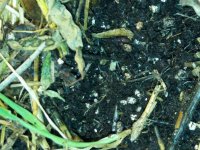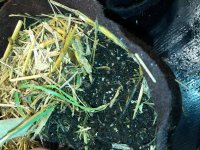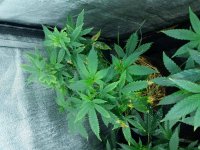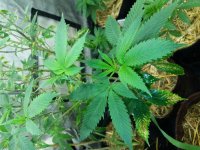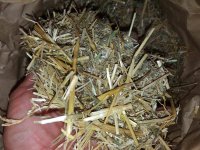hello good in the end I made a mix with what I had on hand that was:
BASE MIX:
+ 70% land that had been used and recycled only with earthworm humus
***********and biobizz and bioblom, of the all-mix type, already had perlite.
+ 30% Earthworm Humus and added perlite.
INCREASE:
I've just put worm humus and I'm testing with Neem flour
+ I have an earthworm in motion that I feed with coffee grounds and banana peels, lettuce, aloe and what is left of the TAC, s and the SST.
FLOWERING:
+ Palm Ash (0-1-30) 333gr x 50L Base Mix
+ Guano Murcielago (2-10-1) 166gr x 50L Base Mix
I bought a guano of Jamaican bat (8-29-2) recommended dose 100gr x 30L of soil.
the problem I am having with some plants is that they have the leaves on the yellow edges and burns I have measured the ph by taking 1 pieces of soil: 2 part of water and it gave me between ph9 and ph8.7 I took some Californian worms I put them in the pots I put a layer of humus d elombriz about 2cms wide and I have watered with TAC and SST (alfalfa and Corn) + humic and fulvic acids I think that my problem is with the alkalinity of the ash, I think it only remains for me to continue giving them TAC and SST and expect the microbiology to regulate the PH[/QUOTE]
BASE MIX:
+ 70% land that had been used and recycled only with earthworm humus
***********and biobizz and bioblom, of the all-mix type, already had perlite.
+ 30% Earthworm Humus and added perlite.
INCREASE:
I've just put worm humus and I'm testing with Neem flour
+ I have an earthworm in motion that I feed with coffee grounds and banana peels, lettuce, aloe and what is left of the TAC, s and the SST.
FLOWERING:
+ Palm Ash (0-1-30) 333gr x 50L Base Mix
+ Guano Murcielago (2-10-1) 166gr x 50L Base Mix
I bought a guano of Jamaican bat (8-29-2) recommended dose 100gr x 30L of soil.
the problem I am having with some plants is that they have the leaves on the yellow edges and burns I have measured the ph by taking 1 pieces of soil: 2 part of water and it gave me between ph9 and ph8.7 I took some Californian worms I put them in the pots I put a layer of humus d elombriz about 2cms wide and I have watered with TAC and SST (alfalfa and Corn) + humic and fulvic acids I think that my problem is with the alkalinity of the ash, I think it only remains for me to continue giving them TAC and SST and expect the microbiology to regulate the PH[/QUOTE]

